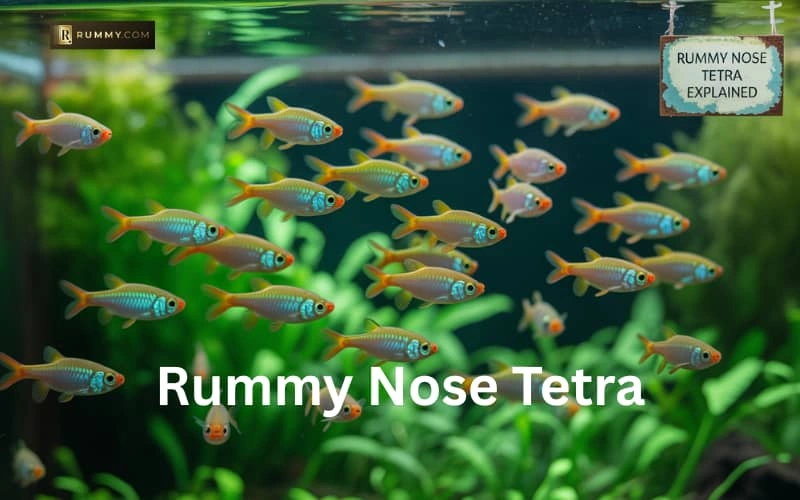Understanding the Rummy Nose Tetra
The rummy nose tetra is a peaceful and eye-catching freshwater fish popular among aquarists for its vibrant red nose and shimmering silver body. This tropical species is often chosen for community aquariums due to its unique appearance and calm temperament Rummy88. Native to the Amazon River basin in South America, the rummy nose tetra thrives in well-maintained tanks that mimic its natural environment. It is a schooling fish that prefers to stay in groups and displays the best color and behavior when kept with its own kind.
Aquarists love the rummy nose tetra for its peaceful nature and synchronized swimming patterns. Its red nose is not just for show—it can indicate the fish’s health and stress levels. The more vibrant the red, the healthier the fish is. This makes it both an ornamental and a functional addition to the aquarium.
Fast Fact 1: The Origin and Habitat of the Rummy Nose Tetra
The rummy nose tetra originates from South America, specifically from the blackwater rivers of Brazil, Colombia, and Venezuela. These waters are soft, slightly acidic, and rich in tannins. These conditions are ideal for the rummy nose tetra’s survival and well-being. In the wild, they are found in densely planted areas and often swim in large schools.
When replicating their natural habitat in home aquariums, it’s important to keep the water soft and slightly acidic, with plenty of plants and hiding spaces. Driftwood and leaf litter can help simulate the dark, tannin-rich waters they are used to. Maintaining a steady temperature between 75°F and 82°F also helps ensure their comfort.
Fast Fact 2: Appearance and Coloration
The rummy nose tetra is known for its distinct appearance. It has a torpedo-shaped body that is mostly silver with a bright red face and nose. Its tail features horizontal black and white stripes that resemble a checkered flag. This unique color combination makes the rummy nose tetra stand out in any community tank.
Interestingly, the red coloration of the nose intensifies when the fish is healthy and relaxed. A fading red nose could be an early sign of stress or poor water quality. The contrast between its silver body and striking red face is a major reason aquarists choose this fish for decorative aquariums.
Fast Fact 3: Behavior and Schooling Patterns
The rummy nose tetra is a peaceful fish that thrives in schools of six or more. When kept in groups, these fish exhibit synchronized swimming behavior that is both fascinating and calming to watch. This behavior helps the fish feel secure and reduces stress in the tank.
Keeping fewer than six rummy nose tetras can lead to stress, making them more susceptible to disease. A larger school encourages natural behavior and improves their overall health. These fish do well in community tanks with other peaceful species, such as neon tetras, guppies, and dwarf corydoras.
Fast Fact 4: Tank Setup and Requirements
To ensure the health of your rummy nose tetra, the tank should be set up with the following parameters:
- Tank size: Minimum 20 gallons
- Temperature: 75°F to 82°F
- pH: 6.0 to 7.0
- Water hardness: Soft to moderately soft
- Lighting: Low to moderate
- Filtration: Gentle, as they dislike strong currents
A well-planted tank with subdued lighting mimics the tetra’s natural habitat. Adding driftwood, live plants, and floating vegetation provides both cover and comfort. Regular water changes are crucial because rummy nose tetras are sensitive to changes in water quality.

Fast Fact 5: Feeding Habits
The rummy nose tetra is an omnivore with a diet that includes both animal and plant-based foods. In the wild, they feed on small insects, larvae, and plant matter. In captivity, they readily accept:
- High-quality flake or micro-pellet food
- Frozen or live brine shrimp
- Daphnia and bloodworms
- Spirulina-based foods for color enhancement
Feeding should be done 2 to 3 times a day in small portions. Overfeeding can lead to water quality issues, which in turn can affect the health of the rummy nose tetra. A varied diet helps them maintain vibrant coloration and supports overall health.
Fast Fact 6: Health and Lifespan
The average lifespan of a rummy nose tetra is between 5 to 6 years when kept in optimal conditions. However, their sensitivity to water parameters makes them more susceptible to stress-related illnesses if the tank is not properly maintained.
Signs of good health include a bright red nose, active swimming, and tight schooling behavior. Common health concerns include:
- Ich (white spot disease)
- Fin rot
- Stress-related illness due to poor water quality
Quarantining new fish before adding them to the tank helps prevent the spread of diseases. Regular tank maintenance, including weekly water changes and monitoring ammonia, nitrite, and nitrate levels, is essential.
Fast Fact 7: Breeding Rummy Nose Tetras
Breeding the rummy nose tetra can be challenging, especially for beginners, due to their sensitivity to water changes and their need for precise conditions. To successfully breed them, follow these tips:
- Set up a separate breeding tank with soft, slightly acidic water
- Use a sponge filter to protect the fry from being sucked in
- Provide plenty of live plants or a spawning mop for egg-laying
- Maintain water temperature around 80°F
Once spawning occurs, the adults should be removed to prevent them from eating the eggs. Eggs typically hatch within 24 to 36 hours. The fry can be fed infusoria or powdered fry food until they are large enough to consume baby brine shrimp.
Breeding success greatly depends on maintaining stable water conditions and providing a stress-free environment. While breeding the rummy nose tetra is not as straightforward as other species, it can be a rewarding experience for experienced aquarists.
Final Thoughts on the Rummy Nose Tetra
The rummy nose tetra is a beautiful, peaceful, and active addition to any community tank. Its shimmering body, bright red nose, and synchronized swimming behavior make it a favorite among aquarium enthusiasts. While it requires specific water parameters and good maintenance, the visual appeal and interactive nature of this fish make the effort worthwhile.
Understanding the behavior, diet, and tank requirements of the rummy nose tetra helps ensure a thriving and vibrant aquarium. Whether you are a beginner looking to expand your fish-keeping knowledge or an experienced aquarist wanting to add elegance to your tank, the rummy nose tetra is a reliable and attractive choice.






